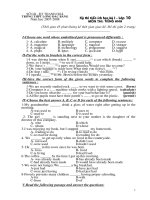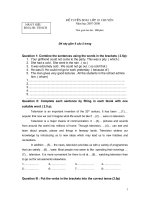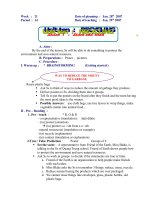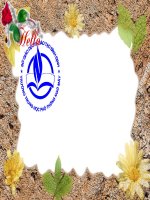Unit 10 Recycling -Tiếng anh 8
Bạn đang xem bản rút gọn của tài liệu. Xem và tải ngay bản đầy đủ của tài liệu tại đây (112.3 KB, 11 trang )
UNIT 10 RECYCLING
( Total : 5 periods )
I. Aims :
Helping students:
-To give and respond to instructions.
-To talk about feelings.
-To write a set of instructions.
II. Language contents :
1. Grammar:
1. Passive form .
2. Adjective followed by - an infinitive .
- a noun clause
3. present simple
4. future simple
2. Vocabulary :
Nouns Verbs
Natural resources compost decompose reuse
Deposit fabric reduce contact
fertilizer glassware refill
metal representative protect
III. Skills : Listening , Speaking , Reading and Writing
IV. Unit allocation
Lesson 1
Getting started
Listen and read
Reading a dialogue for details about how to protect the
environment and save natural resources .
Lesson 2
Speak &
Listen
Practicing in giving and responding to instructions .
Listening for specific information about making compost .
Lesson 3
Read Reading the text for details about how things are recycled
.
Lesson 4
Writing Writing a set of instructions on how to recycle used
things .
Lesson 5
Language focus Further practice in Passive form ,
Adjective followed by - an infinitive .
- a noun clause
138
Week: 22
nd
Preparing Day: 18/01/2013
Period: 64
th
Teaching Day: 22/01/2013
UNIT 10 RECYCLING
Lesson 1 GETTING STARTED & LISTEN AND READ
I./ Objectives:
1 – Educational aims: Make environment clearly.
By the end of the lesson, students should know about reuse, reduce, recycle
2 – Teaching aims: students can talk about recycle things
II./ Language Contents:
1 – Grammar: Adjectives followed by an infinitive or noun clause.
2 – Vocabulary: -Representative (n),-Recycle (v), instead of (adv), plastic (n), reuse (v), wrap (v),
fertilizer (n), reduce (v), over packaged (adj).
III./ Techniques: Eliciting, asking and answering, T/F.
IV./ Teaching aids: Pictures and flash card, cassette
V./ Procedures.
Teacher’s activities
1. Warm up:
-Asking some questions:
What do you do with waste paper / empty bottle?
Do you always collect them?
2. Presentation:
-Have students work in pairs and think of the ways
we can reuse garbage.
-Explain new words.
*New words:
-Representative (n) người đại diện
Recycle (v) tái chế
instead of (adv) thay vì
plastic (n) nhựa
reuse (v) sử dụng lại
wrap (v) gói, bao
fertilizer (n) phân bón
reduce (v) giảm bớt
over packaged (adj) đóng gói quá nhiều
* Structure :
Passive form : be+ Vpp
-Guides students how to read new words.
-Have students read the dialogue and show real
things such as bottle, sock…
- Let students listen to the tape.
-Explain new structure: Adj + To – infinitive / noun
clause
3. Practice:
Students’ activities
-Answer
-Guess
-Copy the new words
-Role-play
-Read and check
-Work in pairs
-Individuals
- Read the dialogue
139
- Have students work in pairs or in groups.
- Get feedback.
- Listen and correct the answers
a) Reduce means not buying products which are over
packaged.
b) We can reuse things like envelopes, glass, plastic
bottles, and old plastic bags….
c) Recycle means try and find another use
d) We can contact…friends.
e) We shouldn’t use plastic bags because when we
throw them away they can stay there for a long time
4. Production :
* Choose T/ F
a) Friends of the Earth is an organization to help
people make friends with each other.
b) Miss. Blake asks the students to remember three
things: reduce, reuse, recycle.
c) Reduce means buying the products which are
overpacked.
d) We can’t reuse things like envelopes, glass, plastic
bottles, old plastic bags.
5. Homework :
-Write 5 sentences about your habits in the past.
-Do exercises in Workbook.
-Prepare the part : Speak & Listen
- Answer the questions
* Answer.
a) F. … to help people protect the
environment and save natural
resources.
b) T
c) F. Reduce means not buying …
d) F. We can reuse things
VI. Comments:
Week: 22
nd
Preparing Day: 18/01/2013
Period: 65
th
Teaching Day: 23/01/2013
140
UNIT 10 RECYCLING
Lesson 2 SPEAK & LISTEN
I. Objectives:
Practicing in giving and responding to instructions.
Listening for specific information about making compost.
II./. Language contents:
1- Vocabulary:
leather, compost heap, moisture, condensation.
2- Grammar: Review
III./. Techniques: Eliciting question and answer, Role play, Guessing game, description.
IV./. Teaching aids: - Pictures, tape
V. Procedures:
141
Teacher’s activities
1. Warm- up
Play Kim’s game
-show the picture to the students and ask them to observe it
carefully, let them look at the picture for about 20 second
them put it away.
-divide the class into 2 groups.
-ask them to go to the board and write as many words
showing things in the picture as possible.
2. Speak.
a. Pre-Speaking:
-Have students play the game “network”
-Get feedback.
b. While -Speaking:
- Divide class into 4 groups
- Have students base on the game above and call the
names of the things with belong to each group
plastics Glasses papers
- Give new words and explain.
- Get feedback
c. Post – Speaking:
- Give instruction:
T – Ss : Which group… ? Put them in…………
What can we … ? We can…………………
What will we… ? We make ……………
- Have Ss practice by pairs work.
- Get feedback.
2. Listen
a. Pre-Listening:
- Have Ss answers some eliciting questions.
“Is it easy to make compost ?/ what do you use to make
compost ? / where do you keep the compost ? ”
- Have Ss answers some questions above .
-Introduce new word and help Ss read new words: compost
heap, moisture, condensation,…
b. While-Listening:
Set up the task:
-Have Ss guess
- play the tape.
- Have Student listen to the tape again -> Teacher
correction.
* Have Ss listen and stick the information you hear.
a. ____use only vegetables matter.
b. ____ find a place that get sun and share.
c. ____we should ruse vegetable matter to make animal
Teacher’s activities
-play a game
Answer:
garbage
-Work in groups
-Individuals
-Work in pairs
-Listen
- Answer.
-Listen and repeat new words
-Read the new words
- Work in pairs
-Compare in group.
-Listen and check. Then write
the answer on the board.
142
VI. Comments:
Week: 22
nd
Preparing Day: 20/01/2013
Period: 66
th
Teaching Day: 25/01/2013
UNIT 10 RECYCLING
Lesson 3 READ
I. Objectives :
By the end of the lesson, students should know things which can be recycled and how to protect
the environment.
II./ Language Contents:
1 . Vocabulary:
-pipe(n),refill(v), melt (v), glassware(n), law(n), deposit (n), compost(n), dung(n)
2. Grammar: passive form
III./ Techniques:
Eliciting, Q & A , multiple choice.
IV./ Teaching aids: Hand out.
V. Procedures:
Teacher’s activities
1. Warm up:
Describing tow pictures: “clean street and street with the
garbage” and ask some questions
* Which do you prefer?
What do people do to have clean streets?
What do people do with things collected?
2. Pre-Reading :
-Introduce the situation “Now we are going to read a
newspaper named “The Green Grazette”
It tells us some ways to protect the environment
-Have student read silently the text and find new words.
+ Explain some new words.
- Pipe, refill, glassware, deposit, compost, dung, law, melt…
Have students read the text by chorus or individual.
-Teaching the structures: Tobe + V.pp
Example: The glass is recycled.
3. While-Reading:
1. Answer.
-Have Students read the text again then find out answers.
a) What do people do with empty milk bottle?
b) What happens to the glass when it is sent to the factories?
Teacher’s activitites
- Look at the pictures and describe.
- Answer the question.
Groups work.
Picture / minimizing
Read silently.
-Give out the new words.
- Read the text again and notice how to
pronunciation new words.
-Work in pairs.
- Answer the questions
a people cleaned and refilled empty
bottles.
b. the glass is broken up, melted and make
into new glassware.
143
c) What did the Oregon government do to prevent people
from throwing drink cans away?
d) What is compost made from?
e) If you have a recycling story to share, how can you share
it?
- Have students give the answers and teacher correct the
mistakes.
2. Complete the sentences to make a list of recycled things.
Draw the grid on the board and have them copy it.
Ask them to read the text again.
Ask them to work in pair to make a list of recycling facts
mentioned in the text.
Call on them to write the information in the grid on the
board.
-Give the answer:
Car tires are recycled to make pipes and floor coverings.
Milk bottle are cleaned and refilled (with milk)
Glass is broken up, melted and made into new glassware.
Drink cans are brought back for recycling.
Household and garden waste is make into compost.
4. Post-Reading :
- Have students choose T/ F.
a. Tires can be recycled to make shoes and floor covering.
b. Every milk bottles can be reused once.
c. In the USA, thousands of car tires are thrown away.
d. Glass is reused and make into glassware.
5. Homework:-Do exercises : (Workbook)
-Prepare the next lesson. (Writing)
c. The Oregon government make a new law
that there must on drink cans. The deposit
is returned when they bring the cans back
for recycling.
d. compost is make from household and
garden waste.
e. if we have a recycling store to share, we
can call or fax the magazine at 5265456.
-work in pairs.
-do the exercises.
VI. Comments:
Week: 23
rd
Preparing Day: 26/01/2013
Period: 67
th
Teaching Day: 29/01/2013
UNIT 10 RECYCLING
Lesson 4 WRITE
I. Objectives :
By the end of the lesson, students know how to reuse waste things.
Developing writing skill and know how to write a paragraph to recycle some things.
II./ Language Contents:
1 – Vocabulary: soak; place; press; scatter
2 – Grammar: Imperative.
III./ Techniques: Question and answer, gap filling.
144
IV./ Teaching aids: Chart
V. Procedures :
Teacher’s activities
1. Warm up:
Ask students some questions
-“What is paper make from ? Can we recycle old
paper? How do we recycle them?”
2. Pre-Writing:
- Explain some new words from the lesson. Soap
(n), place (n), press (n), scatter…
- Ask students the form of the letter . Guide the
students. How to complete the passage.
- Have students read the passage and the verbs
given in silently to get details and fill in the gaps
with correct tense forms.
- Check and correct.
* Answer.
1) use 2)mix 3)Place 4) press 5)Wrap
6) Wait 7) dry
3. While-Writing :
Task 1:
-Have students look at the pictures and make
instruction with words given.
Task 2 :
- Compare with a partner then go to the board and
write down.
- Call them to say the sentences from memory.
First………………………………………………………….
Then,……………………………………………………
Next,…………………………………………………….
After that,…………………………………………….
Finally,……………………………………………………
- Get them to write the text in brief using the
sequencing.
Answer key.
First, soak old newspaper in a bucket overnight.
Then, mash the paper by a wooden spoon.
Next, mix the mashed paper with water.
After that, use a wire mesh to pull the mixture
out, put it on the cloth and press it down firmly.
Finally, take the mesh out of the cloth and dry it in
Teacher’s activities
-Answers
- (Individual)
- Work in groups.
- Share and compare with other group
-Work in pairs
-Read
-Write (Individual)
- Work in pairs
-Give feedback (self-correct / teacher
corrects)
-Write homework
-Read the recycle instruction.
145
the sun.
- Ask them to write the instructions.
4. Post-Writing
Task 3:
- Have students reread the recycle instruction
“How to recycle waste paper and how to prepare
the tea leaves”
-Get feedback / Correct mistakes
5. Homework:
-Do exercise: in workbook
-Prepare the next lesson.
Answer.
a) First, take the used tea leaves from the
tea pot.
b) Next, scatter the tea leaves on the tray.
c) Then dry the leave in the sun.
d) Finally, put the dry leaves for future
use.
VI. Comments
Week: 23
rd
Preparing Day: 26/01/2013
Period: 68th Teaching Day: 30/01/2013
UNIT 10 RECYCLING
Lesson 5 LANGUAGE FOCUS
I. Objectives :
Students can know how to change from active into passive. Adjective followed by an infinitive or
a noun clause.
II./ Language Contents:
1. Vocabulary: detergent, blow, stir, relieved
2. Grammar: Passive voice; Adj + To infinitive; Adj + noun clause
III./ Techniques:
Ordering, matching, eliciting, Q & A.
IV. Teaching aids:
146
pictures, posters, sub boards
V. Procedures:
Teacher’s activities
1. Act 1: Passive forms
a) Passive form with the present perfect.
-Explain how to use “ Passive voice”
( S + Be + V
(pp)
+ By + O)
Ex: He breaks the glass into small pieces. (active voice)
-> The glass is broken into small pieces by him.(passive
voice)
-Have students read example.
- Do the exercise 1 change into passive voice.
Answer:
b. Then the glass is washed with a detergent liquid.
c. The glass pieces are dried completely.
d. The mixture is melted until becomes a liquid.
f. A long pipe is used. It is dipped into the liquid, then the
liquid is blown into intended shapes.
-Check and correct
- Call some students to match sentence with pictures.
- Call some pairs to answer.
- Correct
* Answers: a – 1, b – 4, c – 3, d – 5, e – 2, f - 6
b) Passive form with simple future (L F 2)
- Help students how to use passive form with future simple.
S + WILL + BE + Vpp
EX: The project will be started on time.
- Have students read instruction.
- Have students work in pairs to complete the dialogue.
- Call some pairs to read.
- Listen and correct.
* Answer.
1. It will be shown …
2. Will it be built …
3. it will be finished …
4. Will it be made …
2. Act 2: Adjectives followed by an infinitive/ a noun
clause.
-Explain the structure
“Adj + To_infinitive/ Adj + noun clause”
Ex: it is difficult to learn English
-Have Ss work in pairs.
Teacher’s activities
-Read
-Work in pairs
-Listen and remember
-Work in pairs
- Work individual.
- Answer.
-Listen
- Write.
-Work in pairs
147
-Call some pairs do it again.
-Listen and correct some mistakes
4. Homework :
-Do all exercises in Workbook
-Learn by heart the structures.
-Prepare the next lesson: Unit 11 Getting Started
Listen and read.
VI. Comments
148









